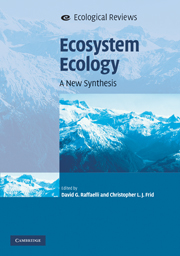Book contents
- Frontmatter
- Contents
- List of contributors
- Preface
- 1 The evolution of ecosystem ecology
- 2 Linking population, community and ecosystem ecology within mainstream ecology
- 3 Thermodynamic approaches to ecosystem behaviour: fundamental principles with case studies from forest succession and management
- 4 Ecosystem health
- 5 Interdisciplinarity in ecosystems research: developing social robustness in environmental science
- 6 The links between biodiversity, ecosystem services and human well-being
- 7 Ecosystem ecology and environmental management
- Index
- References
2 - Linking population, community and ecosystem ecology within mainstream ecology
Published online by Cambridge University Press: 05 June 2012
- Frontmatter
- Contents
- List of contributors
- Preface
- 1 The evolution of ecosystem ecology
- 2 Linking population, community and ecosystem ecology within mainstream ecology
- 3 Thermodynamic approaches to ecosystem behaviour: fundamental principles with case studies from forest succession and management
- 4 Ecosystem health
- 5 Interdisciplinarity in ecosystems research: developing social robustness in environmental science
- 6 The links between biodiversity, ecosystem services and human well-being
- 7 Ecosystem ecology and environmental management
- Index
- References
Summary
Introduction
Charles Darwin's tangled bank provides one of the best-known early descriptions of an ecosystem:
It is interesting to contemplate a tangled bank, clothed with many plants of many kinds, with birds singing on the bushes, with various insects flitting about, and with worms crawling through the damp earth, and to reflect that these elaborately constructed forms, so different from each other, and dependent on each other in so complex a manner…
This description highlights much of the complexity of ecosystems, comprising various biotic components (plants, vertebrates and invertebrates), abiotic factors (soil) and environmental conditions (humidity). Even though this list comprises only a fraction of the likely diversity within the ecosystem, and Darwin has combined many individual species into single groups (plants, birds, insects), the stated inter-dependencies emphasise the large number of potential direct and indirect interactions that may occur among the various components, and between them and the environment.
Understanding the functioning of ecosystems, determining the factors underlying their structure and predicting their responses to perturbations are major challenges that have formed the lifeblood of population, community and ecosystem ecology for decades. Given the daunting task of addressing these issues empirically, mathematical models have played a vital role in this research. By simplifying the complexity of an ecosystem, formalising hypotheses and often producing testable predictions, mathematical models can provide invaluable insights into the processes shaping ecosystems and, from an applied perspective, inform the development of management policies (e.g. species conservation, land management, harvesting regimes).
- Type
- Chapter
- Information
- Ecosystem EcologyA New Synthesis, pp. 19 - 39Publisher: Cambridge University PressPrint publication year: 2010
References
- 1
- Cited by



